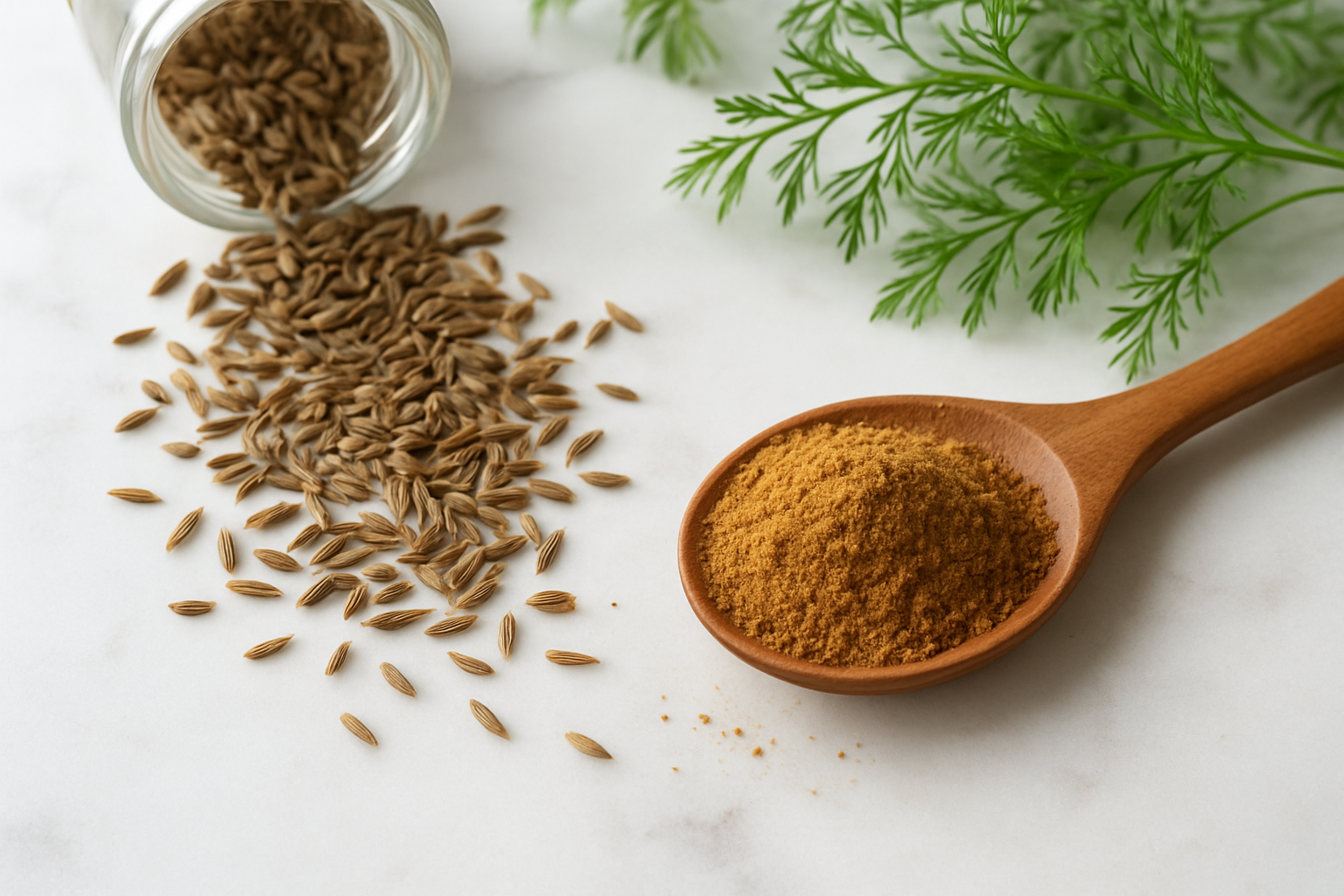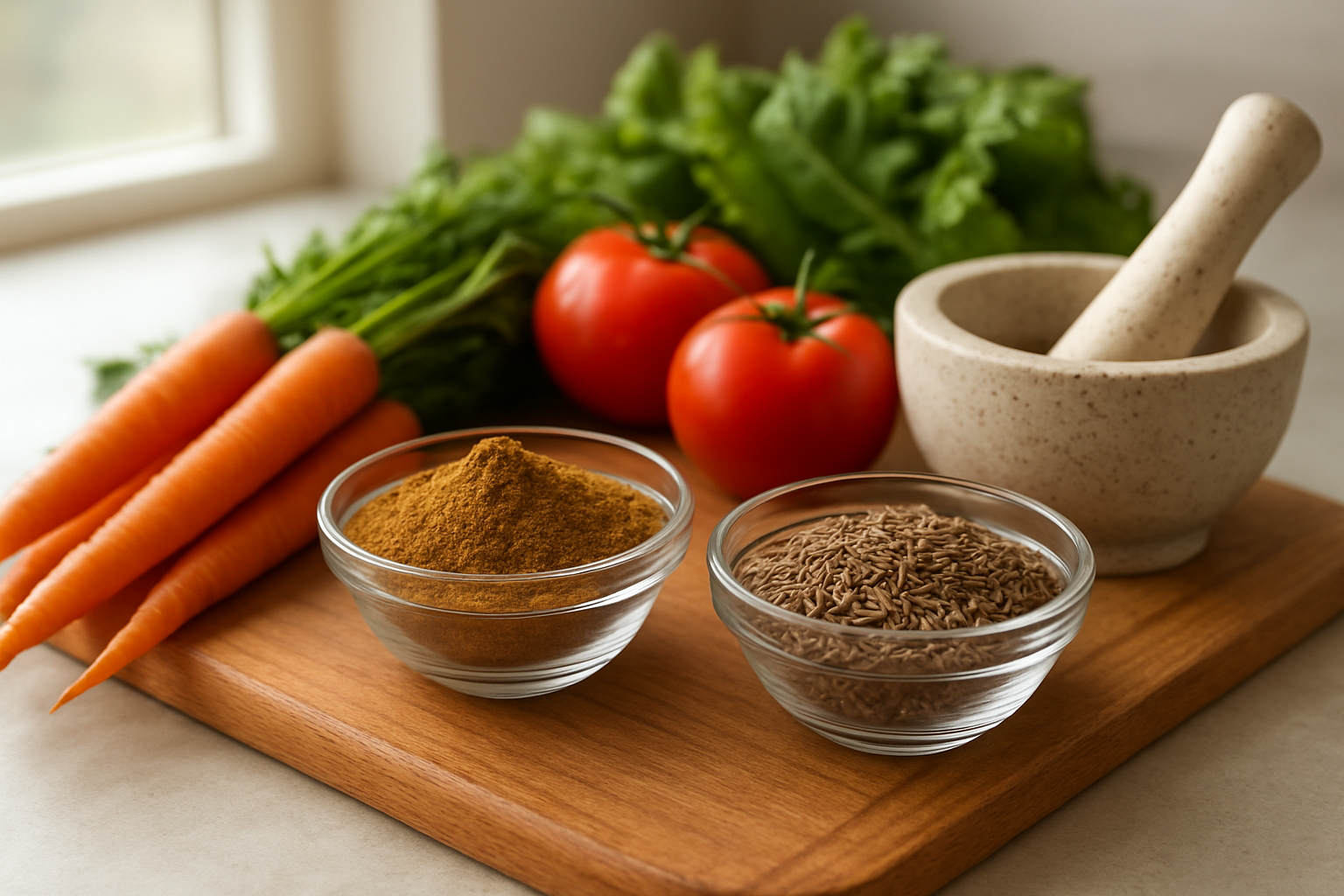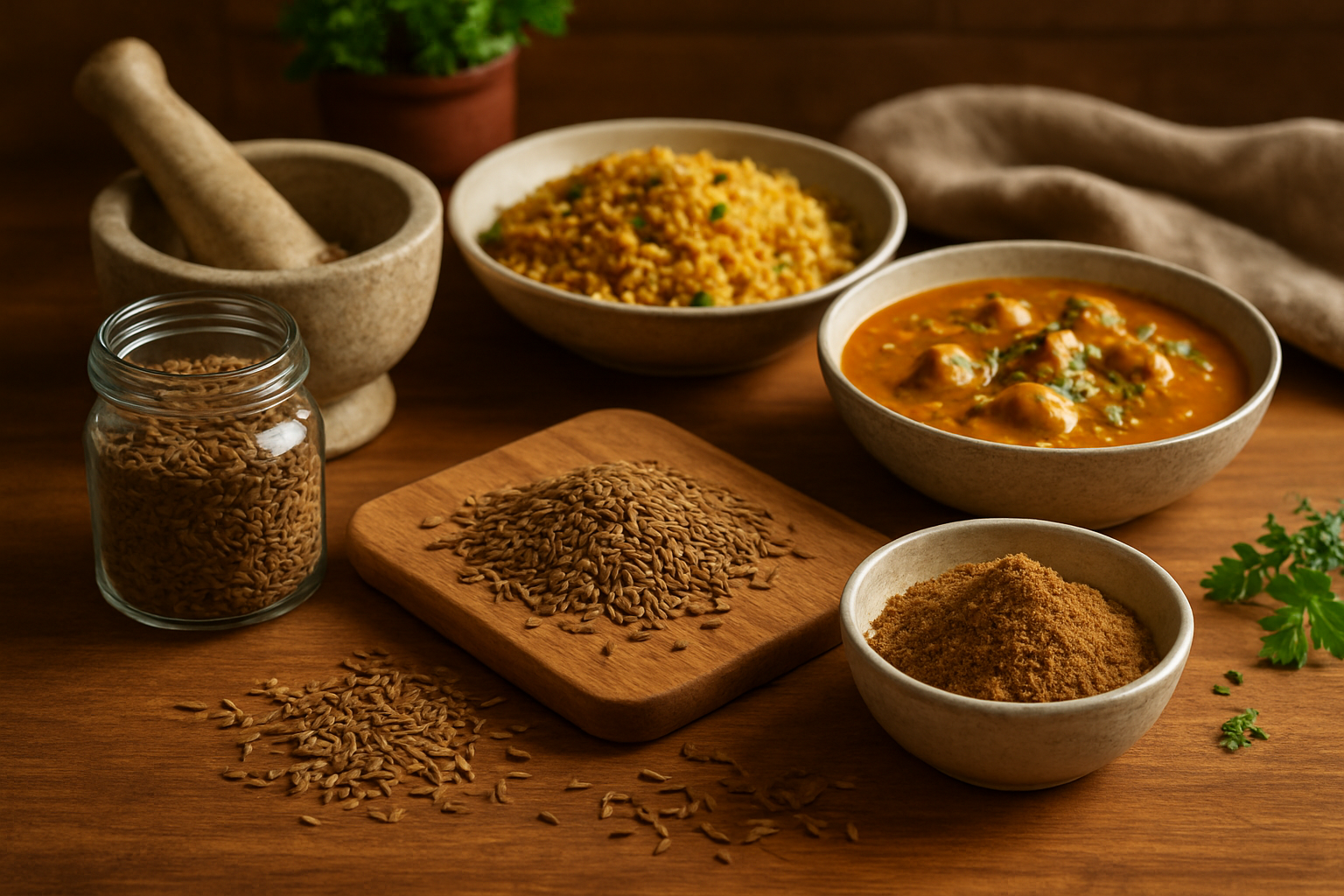Cumin isn’t just another spice sitting in your pantry—it’s a nutritional powerhouse that can transform both your health and your cooking. This aromatic seed has been prized for centuries, and modern science is now catching up to what traditional healers have long known about its remarkable benefits.
This guide is perfect for home cooks who want to boost their family’s health naturally, health-conscious individuals looking for simple dietary additions, and anyone curious about adding more flavor and nutrition to their meals.
We’ll explore the impressive health benefits of regular cumin consumption, from improved digestion to better blood sugar control. You’ll also discover practical ways to incorporate this versatile spice into your daily routine, plus get access to delicious cumin-based recipes that work for breakfast, lunch, and dinner. By the end, you’ll know exactly how to make cumin work for your lifestyle and taste preferences.
What Makes Cumin a Nutritional Powerhouse

Essential Vitamins and Minerals in Cumin
Cumin seeds pack an impressive array of essential nutrients despite their tiny size. Just one teaspoon of ground cumin delivers approximately 20% of your daily iron needs, making it particularly valuable for people with iron deficiency or those following plant-based diets. The iron in cumin is easily absorbed by the body, helping prevent anemia and supporting healthy blood cell formation.
Beyond iron, cumin contains significant amounts of manganese, which plays a crucial role in bone development and wound healing. A single teaspoon provides about 10% of your daily manganese requirements. The spice also offers copper, essential for maintaining healthy connective tissues and supporting immune function.
The vitamin profile of cumin includes vitamin A, which supports eye health and immune function, along with B-complex vitamins like thiamine and riboflavin that help convert food into energy. Magnesium and calcium found in cumin support bone health and muscle function, while phosphorus contributes to strong teeth and bones.
What makes these nutrients even more valuable is their bioavailability. The natural compounds in cumin enhance the absorption of these minerals and vitamins, meaning your body can actually use them effectively rather than simply passing them through your system.
Antioxidant Properties That Fight Free Radicals
Cumin’s antioxidant power comes from a variety of plant compounds that work together to combat oxidative stress in your body. The primary antioxidant compound, cuminaldehyde, gives cumin its distinctive aroma while providing powerful cellular protection. This compound has shown remarkable ability to neutralize harmful free radicals that can damage cells and contribute to premature aging.
The spice contains flavonoids like apigenin and luteolin, which research shows can help reduce inflammation throughout the body. These compounds work at the cellular level to prevent oxidative damage that leads to chronic diseases and cellular aging.
Phenolic compounds in cumin add another layer of antioxidant protection. These natural chemicals help stabilize cell membranes and protect DNA from damage. Studies have found that cumin’s antioxidant activity rivals that of vitamin C in certain laboratory tests, showing its remarkable protective potential.
The cumulative effect of these antioxidants creates a synergistic defense system. When you consume cumin regularly, these compounds work together to create a protective shield around your cells, helping maintain healthy cellular function and potentially reducing the risk of chronic diseases linked to oxidative stress.
Low Calorie Profile with Maximum Flavor Impact
One teaspoon of ground cumin contains just 8 calories, making it an incredibly efficient way to add bold flavor without impacting your caloric intake. This minimal calorie count means you can use cumin liberally in your cooking without worrying about adding unwanted calories to your meals.
The flavor intensity of cumin far exceeds its caloric contribution. Its warm, earthy, and slightly bitter taste can transform bland dishes into exciting culinary experiences. This makes cumin particularly valuable for people trying to maintain or lose weight, as it allows them to enjoy flavorful, satisfying meals without relying on high-calorie flavor enhancers like heavy sauces or excessive fats.
| Nutrient | Per 1 tsp (2.1g) |
|---|---|
| Calories | 8 |
| Protein | 0.4g |
| Fat | 0.5g |
| Carbs | 0.9g |
| Fiber | 0.2g |
The virtually fat-free and low-carbohydrate nature of cumin makes it suitable for various dietary approaches, including ketogenic, low-fat, and diabetic-friendly eating plans. Unlike many flavor enhancers that come with hidden calories from sugars or fats, cumin delivers pure taste with minimal nutritional cost, allowing you to create delicious, health-conscious meals that don’t compromise on flavor or satisfaction.
Proven Health Benefits of Regular Cumin Consumption

Improves Digestive Health and Reduces Bloating
Cumin works like a natural digestive aid, helping your stomach break down food more efficiently. The active compounds in cumin, particularly cuminaldehyde, stimulate the production of digestive enzymes that help process proteins, fats, and carbohydrates. When you regularly include cumin in your meals, you’re giving your digestive system the support it needs to function at its best.
People dealing with bloating and gas often find relief when they add cumin to their diet. The spice contains carminative properties that help reduce intestinal gas formation and promote its elimination. This makes cumin especially helpful after heavy meals or when eating foods that typically cause digestive discomfort.
Research shows that cumin can increase bile production, which plays a crucial role in fat digestion. Better bile flow means your body can process fatty foods more effectively, reducing that heavy feeling you sometimes get after rich meals.
Boosts Immune System Function
Your immune system gets a real boost from cumin’s impressive antioxidant profile. The spice contains compounds like flavonoids and phenolic acids that help protect your cells from damage caused by free radicals. These antioxidants work together to strengthen your body’s natural defense mechanisms.
Cumin also has antimicrobial properties that help fight off harmful bacteria and fungi. Studies have shown that cumin extract can inhibit the growth of certain foodborne pathogens, adding an extra layer of protection to your meals.
The iron content in cumin supports immune function by helping produce healthy white blood cells. When your iron levels are adequate, your immune system can respond more effectively to threats and maintain better overall health.
Supports Weight Management and Metabolism
Adding cumin to your routine can give your metabolism a gentle nudge in the right direction. Research indicates that cumin consumption may help increase the body’s heat production, a process called thermogenesis, which can boost calorie burning throughout the day.
Several studies have found that people who regularly consume cumin experience improvements in body composition. One notable study showed that participants who added cumin powder to their diet lost more weight and reduced their body fat percentage compared to those who didn’t use the spice.
Cumin may also help regulate appetite by influencing hormones that control hunger and satiety. This natural appetite regulation can make it easier to maintain healthy eating habits without feeling constantly hungry or deprived.
Regulates Blood Sugar Levels Naturally
Cumin shows promising effects on blood sugar management, making it a valuable spice for people concerned about glucose levels. The compounds in cumin help improve insulin sensitivity, which means your cells can use glucose more effectively for energy rather than storing it as fat.
Studies have demonstrated that cumin consumption can lead to significant reductions in fasting blood sugar levels. The spice appears to slow down the absorption of sugar in the intestines, preventing those sharp spikes in blood glucose that can occur after meals.
Regular cumin use may also help reduce glycated hemoglobin (HbA1c) levels, which is a marker of long-term blood sugar control. This makes cumin a smart addition to a diabetes-friendly eating plan.
Enhances Iron Absorption for Better Energy
Iron deficiency affects millions of people worldwide, and cumin can be a natural way to boost your iron levels. Just one teaspoon of ground cumin provides about 1.4 milligrams of iron, which is roughly 8% of the daily recommended intake for adults.
What makes cumin even more valuable is its ability to enhance iron absorption from other foods. The spice contains compounds that help your body absorb iron more efficiently from plant-based sources, which is especially beneficial for vegetarians and vegans who rely on non-heme iron sources.
Better iron levels translate to improved energy throughout the day. When your body has adequate iron, it can transport oxygen more effectively to your muscles and organs, reducing fatigue and supporting better physical and mental performance.
Different Forms of Cumin and Their Best Uses

Whole Cumin Seeds for Maximum Potency
Whole cumin seeds pack the most nutritional punch and deliver superior flavor compared to their processed counterparts. When you buy seeds intact, their essential oils and volatile compounds remain protected by the outer shell, preserving their therapeutic properties for months when stored properly in a cool, dry place.
The best way to unlock their full potential is through dry roasting. Heat a pan over medium heat, add the seeds, and toast them for 2-3 minutes until they become fragrant and slightly darker. This process releases their natural oils and creates a deeper, nuttier flavor that transforms any dish.
Whole seeds work beautifully in:
- Tempering for Indian curries and dals
- Marinades for grilled meats and vegetables
- Slow-cooked stews and braises
- Homemade spice blends when ground fresh
- Pickling spice mixtures
Keep whole seeds in airtight containers away from light and heat. They’ll maintain their potency for up to two years, though their flavor peaks within the first year.
Ground Cumin Powder for Easy Integration
Ground cumin offers convenience without sacrificing too much flavor, making it perfect for everyday cooking. Pre-ground cumin integrates seamlessly into batters, rubs, and sauces where whole seeds might create unwanted texture.
Fresh grinding makes a noticeable difference in taste. If you have a spice grinder or mortar and pestle, grind whole seeds in small batches rather than buying large containers of pre-ground powder. Ground cumin loses its volatile oils quickly, so buy smaller quantities and replace them every 6-8 months.
Ground cumin shines in:
- Spice rubs for barbecue and roasted meats
- Salad dressings and vinaigrettes
- Smoothies and protein shakes
- Baked goods like bread and crackers
- Quick weeknight stir-fries
Store ground cumin in small, airtight containers. Label them with purchase dates and keep them away from your stove where heat can accelerate flavor loss.
Cumin Essential Oil for Therapeutic Applications
Cumin essential oil concentrates the seed’s active compounds into a potent therapeutic form. Steam distillation extracts the volatile oils, creating a powerful amber-colored liquid with intense aroma and concentrated health benefits.
This form requires careful handling due to its strength. Never apply cumin essential oil directly to skin without diluting it first – typically 1-2 drops per tablespoon of carrier oil like coconut or jojoba oil.
Therapeutic applications include:
- Aromatherapy diffusion for digestive support (2-3 drops in a diffuser)
- Topical massage blends for muscle tension (properly diluted)
- DIY cleaning products for antibacterial properties
- Natural insect repellent formulations
Quality matters significantly with essential oils. Look for organic, therapeutic-grade oils from reputable suppliers who provide gas chromatography reports. Store bottles in dark glass containers away from heat and light, where they’ll maintain potency for 2-3 years.
Always consult healthcare providers before using cumin essential oil medicinally, especially if you’re pregnant, nursing, or taking medications.
Simple Methods to Incorporate Cumin into Your Daily Diet

Toasting Techniques for Enhanced Flavor Release
Whole cumin seeds reach their full aromatic potential when you toast them before use. Heat a dry skillet over medium heat and add the seeds, stirring constantly for 2-3 minutes until they become fragrant and slightly darker. You’ll know they’re ready when they start to pop and release their distinctive earthy aroma.
Ground cumin also benefits from gentle toasting. Add it to your dry pan for just 30-60 seconds, stirring continuously to prevent burning. This quick process intensifies the flavor and removes any raw, bitter notes. The toasted spice should smell warm and nutty – if it turns bitter or starts smoking, the heat was too high.
For oil-based toasting, heat a tablespoon of cooking oil in your pan, add whole seeds, and cook for 1-2 minutes until they sizzle and darken. This method works especially well when you’re starting a curry or stew, as the flavored oil becomes the base for your dish.
Proper Storage Methods to Maintain Freshness
Whole cumin seeds stay fresh much longer than ground versions. Store them in airtight glass containers away from direct sunlight and heat sources. A cool, dark pantry keeps whole seeds potent for up to three years, while ground cumin maintains its best flavor for about two years.
Never store cumin near your stove or window – heat and light break down the essential oils that give cumin its characteristic taste. Small glass jars with tight-fitting lids work better than plastic containers, which can absorb and retain odors.
Check your cumin regularly by crushing a few seeds between your fingers and smelling them. Fresh cumin should have a strong, warm fragrance. If the aroma seems weak or musty, replace your supply. Label containers with purchase dates to track freshness, and buy smaller quantities more frequently rather than large amounts that might lose potency before you use them.
Recommended Daily Dosage for Optimal Benefits
Most nutrition experts suggest consuming 1-2 teaspoons of cumin daily to experience its health benefits without overwhelming your digestive system. This amount provides approximately 3-6 grams of cumin, which research studies have shown to be effective for supporting digestion and metabolism.
Start with smaller amounts if you’re new to cumin – about half a teaspoon daily for the first week. Your taste buds and digestive system need time to adjust to stronger spices. Gradually increase the amount as your tolerance builds.
Pregnant women should limit cumin intake to culinary amounts rather than medicinal doses. People taking diabetes medications or blood thinners should consult their healthcare provider before significantly increasing cumin consumption, as it can affect blood sugar and clotting.
Spread your cumin intake throughout the day rather than consuming it all at once. Add a pinch to morning eggs, sprinkle some on lunch salads, and use it in dinner preparations. This approach helps your body process the spice more effectively while maintaining steady flavor enhancement in your meals.
Best Food Combinations That Complement Cumin
Cumin pairs naturally with other warming spices like coriander, turmeric, and paprika. This classic combination works beautifully in Mediterranean and Middle Eastern dishes, creating depth without competing flavors. Try mixing equal parts cumin and coriander with a pinch of turmeric for a versatile spice blend.
Protein-rich foods benefit enormously from cumin’s earthy notes. Sprinkle ground cumin on chicken, lamb, or beef before cooking, or add whole seeds to lentil and bean dishes. The spice helps break down proteins and makes these foods easier to digest.
Vegetables like carrots, sweet potatoes, and cauliflower develop incredible flavor when roasted with cumin. Toss cut vegetables with olive oil and cumin before roasting – the heat caramelizes the natural sugars while the cumin adds warmth and complexity.
Rice and grain dishes transform with cumin additions. Add whole seeds to your cooking water when preparing rice, quinoa, or bulgur. The grains absorb the flavor as they cook, creating a fragrant foundation for any meal. Yogurt-based dishes and sauces also work well with cumin – the cooling dairy balances the spice’s intensity while creating creamy, flavorful combinations perfect for dips and marinades.
Delicious Cumin-Based Recipes for Every Meal

Breakfast Options with Warming Cumin Spice
Start your morning with a protein-packed Cumin Scrambled Eggs by whisking ground cumin directly into beaten eggs before cooking. The earthy warmth pairs beautifully with the creamy texture, creating a satisfying breakfast that keeps you energized for hours.
Cumin-Spiced Yogurt Parfait transforms ordinary Greek yogurt into an exotic treat. Mix half a teaspoon of ground cumin with honey, layer with fresh berries and granola. The unexpected spice adds complexity while supporting digestive health first thing in the morning.
For those who love hearty breakfasts, try Cumin Breakfast Potatoes. Dice potatoes, toss with olive oil, ground cumin, paprika, and salt, then roast until crispy. These golden cubes make the perfect side for any breakfast plate.
Cumin-Infused Smoothie might sound unusual, but it’s surprisingly delicious. Blend banana, mango, Greek yogurt, a pinch of ground cumin, and coconut milk. The cumin adds warmth without overwhelming the fruit flavors, creating a unique morning drink that’s both refreshing and grounding.
Lunch Recipes That Feature Cumin as Star Ingredient
Mexican-Style Cumin Black Bean Salad showcases cumin’s versatility in cold dishes. Combine black beans, corn, diced tomatoes, red onion, and bell peppers. Dress with lime juice, olive oil, and generous amounts of ground cumin. This protein-rich salad improves in flavor as it sits, making it perfect for meal prep.
Middle Eastern Cumin Rice Pilaf elevates plain rice into an aromatic side dish. Toast whole cumin seeds in oil before adding rice and broth. The toasted seeds release intense flavor that infuses every grain. Add almonds and dried cranberries for texture and sweetness.
Indian-Inspired Cumin Lentil Soup brings comfort and nutrition together. Sauté onions, garlic, and ground cumin before adding red lentils and vegetable broth. The cumin’s earthiness complements the lentils’ natural nuttiness, creating a warming soup that’s both filling and healing.
Moroccan Cumin Chicken Wraps combine tender chicken seasoned with cumin, coriander, and cinnamon, wrapped in warm flatbread with fresh vegetables and yogurt sauce. The cumin provides the foundation for this complex flavor profile that transports your taste buds.
Dinner Dishes Enhanced with Aromatic Cumin
Slow-Cooked Cumin Beef Stew develops deep, complex flavors over hours of gentle cooking. Brown beef with whole cumin seeds, then add vegetables and broth. The long cooking time allows the cumin to mellow and integrate, creating a rich, satisfying meal that’s perfect for cold evenings.
Cumin-Crusted Salmon offers an elegant way to enjoy this spice with seafood. Mix ground cumin with breadcrumbs, herbs, and lemon zest to create a flavorful crust. The fish stays moist inside while the cumin adds warmth that complements the salmon’s natural richness.
Vegetarian Cumin Cauliflower Steaks make vegetables the star. Slice thick cauliflower rounds, brush with olive oil mixed with ground cumin, garlic powder, and smoked paprika. Roast until golden and tender. These “steaks” are hearty enough to satisfy even meat-lovers.
Spanish-Style Cumin Rice with Seafood combines aromatic rice with shrimp, mussels, and scallops. The cumin adds earthiness that balances the briny seafood, while saffron provides color and floral notes. This one-pot meal is both impressive and surprisingly simple to prepare.
Healthy Snacks and Beverages with Cumin Twist
Roasted Cumin Chickpeas make an addictive healthy snack. Drain canned chickpeas, toss with olive oil and ground cumin, then roast until crispy. These protein-packed bites satisfy cravings while providing sustained energy.
Cumin-Spiced Trail Mix elevates ordinary nuts and dried fruit. Toss almonds, cashews, and pumpkin seeds with ground cumin and a touch of sea salt before lightly toasting. The warm spice transforms familiar ingredients into something special.
Golden Cumin Milk serves as a soothing bedtime drink. Heat milk (dairy or plant-based) with ground cumin, turmeric, and honey. This traditional Ayurvedic beverage promotes relaxation and supports digestion after dinner.
Cumin-Lime Sparkling Water provides a refreshing afternoon pick-me-up. Add a pinch of ground cumin and fresh lime juice to sparkling water. The unexpected combination is surprisingly refreshing and helps curb afternoon snack cravings naturally.

Cumin isn’t just another spice sitting in your pantry – it’s a true nutritional powerhouse that deserves a starring role in your kitchen. From supporting digestion and boosting immunity to potentially helping with weight management and blood sugar control, this humble seed packs an impressive array of health benefits. The best part? You don’t need to completely overhaul your cooking routine to enjoy these perks.
Whether you prefer ground cumin for quick seasoning, whole seeds for that extra crunch, or cumin oil for concentrated flavor, there are countless ways to make this spice work for you. Start small by sprinkling it on roasted vegetables, adding it to your morning smoothie, or trying one of the simple recipes that showcase cumin’s versatility. Your taste buds and your body will thank you for making this ancient superfood a regular part of your meals.














